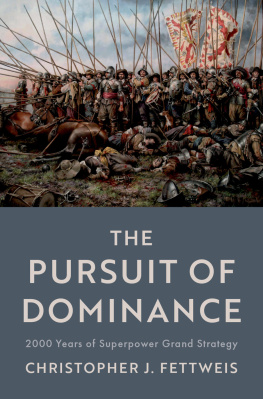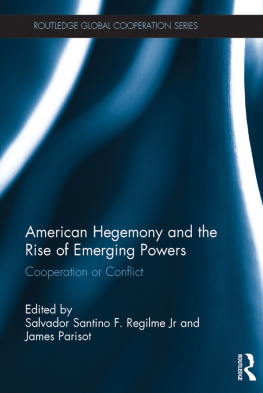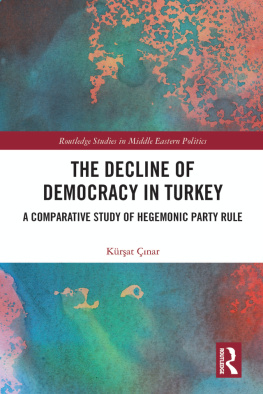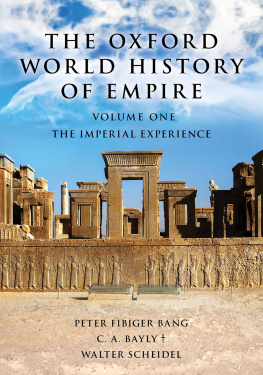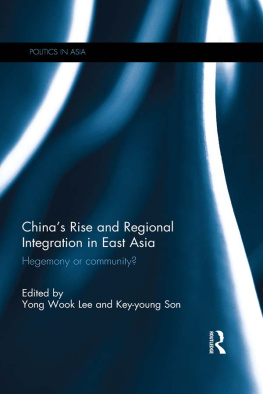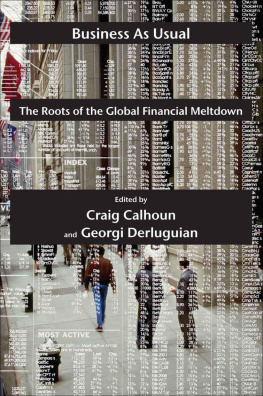First published 2005 by Paradigm Publishers
Published 2016 by Routledge
2 Park Square, Milton Park, Abingdon, Oxon OX14 4RN
711 Third Avenue, New York, NY 10017, USA
Routledge is an imprint of the Taylor & Francis Group, an informa business
Copyright 2005, Taylor & Francis.
All rights reserved. No part of this book may be reprinted or reproduced or utilised in any form or by any electronic, mechanical, or other means, now known or hereafter invented, including photocopying and recording, or in any information storage or retrieval system, without permission in writing from the publishers.
Notice:
Product or corporate names may be trademarks or registered trademarks, and are used only for identification and explanation without intent to infringe.
Library of Congress Cataloging-in-Publication Data
Hegemonic decline : present and past / edited by Jonathan Friedman and
Christopher Chase-Dunn. 1st ed.
p. cm. (Political economy of world-system annuals ; v. XXVI-b)
Includes bibliographical references and index.
ISBN 1-59451-008-3 (hc : alk. paper) ISBN 1-59451-009-1 (pb : alk. paper)
1. Hegemony. 2. HegemonyUnited States. I. Friedman, Jonathan. II.
Chase-Dunn, Christopher K. III. Political economy of the world-system annuals; v. 26-b.
JZ1312. F58 2005
327.1dc22
2005004905
Designed and Typeset by Straight Creek Bookmakers.
ISBN 13: 978-1-59451-008-3 (hbk)
ISBN 13: 978-1-59451-009-0 (pbk)
Jonathan Friedman
Christopher Chase-Dunn
The United States is currently the worlds only military and economic superpower. But the September 11, 2001, terrorist attacks, widely spread unhappiness with U.S. policies among both allies and challengers, and growing discontent with U.S.-led corporate globalization may be signs that the nations superpower status may not last. The apparent vulnerability of the American war machine has also led to speculations that the empire is not really materializing as might have been assumed. This is especially relevant in light of the evidence for actual contraction of the United States in relation to new rising economies, especially in East Asia, a process that has been increasingly visible throughout the past two decades. The place of the United States in the global system of power is one of the main problems examined by prominent sociologists, anthropologists, and geographers from all over the world in this integrated collection of essays on the phenomenon of hegemonic decline. By placing this issue in long-term historical perspective, it becomes possible to elucidate some of the mechanisms involved in the current chaotic situation. A perspective that deals with hegemonic decline as a systemic phenomenon can illuminate phenomena such as counterhegemonic resistance and military adventurism as a desperate attempt to prolong or renew hegemony. A historical perspective can also serve as a corrective to the predominant inevitabilistic and celebratory tone of contemporary globalization discourse in which the advent of a new era is described as transcending the nation-state and expanding human freedom.
This book addresses the difficulties of conceptualizing and assessing hegemonic rise and decline in comparative and historical perspective. Several chapters are devoted to the study of hegemony in premodern and early modern world-systems. Other chapters examine hegemony in the modern world-system, especially comparing the current era of United States primacy with the earlier Dutch and British hegemonies. A final section considers resistance movements and hegemonic transitions by studying transnational indigenism and the relationship between terrorism and hegemonic decline.
The possible futures of the global system are illuminated by careful study of its past and comparisons with power processes in previous eras. The net impact of these chapters is an opening to a broader systematic understanding of the contemporary world as a historical phenomenon, one in which there are significant similarities as well as differences with the past. If the similarities are taken seriously, then we must be driven to reconsider many of our assumptions about the state of the world today and the direction it is taking. If history is replete with replays of notably similar scenarios, then we must ask what we have learned as a species and whether we can avoid such repetition compulsion in the future.
In , On the Way to the Modern World-System, Johnny Persson examines the regional forces in the Aegean world-system that led to the rise of palatial society on Minoan Crete. His approach deals with the nature of exchange relations and the dynamic forms of accumulation within a regional system that emerged within the larger Mediterranean arena in crisis. His chapter suggests that the emergence of palatial society was largely the product of crisis in the larger system.
Kasja Ekholm Friedmans chapter examines the processes of collapse during the Late Bronze Age. She develops a set of hypotheses that link forms of expansion to transformations of class and imperial relations in which the logic of global expansion contains within it the seeds of its own demise. The history of the Middle and Late Bronze Age can be understood here as a reckless trajectory of expansions and contractions, each more accelerated, until the entire region became exhausted. This is, then, not a local model of diminishing returns but a model of global competition that destroys its conditions of reproduction.
Jonathan Friedman considers the similarities and differences between processes of hegemonic rise and decline focusing primarily on the Hellenistic era. He develops a model of cyclical concentration and dissipation of hegemonic control in relation to the accumulation of wealth. And he contends that there are important similarities between contemporary globalization/political fragmentation and previous examples of the same kind of processes. He also proposes that a global systemic and historical account of such processes is the proper corrective for the nave evolutionism of the current globalization discourse.


